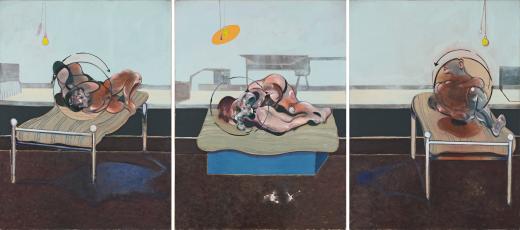TOGETHER, BUT ISOLATED
“I think that the moment a number of figures become involved, you immediately come onto the story-telling aspect of the relationships between figures. And that immediately sets up a kind of narrative. I always hope to be able to make a great number of figures without a narrative.”
Francis Bacon*
In this gallery we can see Velázquez’s portrait of Sebastián de Morra, presented isolated from his surroundings, whose rich clothing alludes to his position within the Hapsburgs. These types of figures, like Pope Innocent X, fascinated Bacon not only thanks to Velázquez’s masterful portrayal but also due to the mysterious air that surrounded these paintings. Bacon revisited these works through his own vision thereby altering our perception of the Spanish master’s oeuvre.
Here we can also see La Bomba, a painting by John Phillip, a Scottish artist who moved to the south of Spain in the mid-19th century for health reasons. This move had major repercussions on the painter, who came to be known as “Spanish Phillip” due to the influence of masters like Velázquez and Murillo on his oeuvre. La Bomba—whose title alludes to the place where this scene is set, perhaps in Granada—was presented by Phillip in London, where it was extremely successful and inspired numerous British artists of his period. The characters in this painting interact with each other in a friendly way, unlike Bacon’s figures, who seem fated to either fight each other or engage in sexual relations, as exemplified by the large triptych which occupies the center of this gallery, Three Studies of Figures on Beds (1972).
The three panels of the triptych have the same background and depict the same scene, although with slight variations in each panel. This three-part format—which Bacon used 33 times over the course of three decades—allowed the artist to show intentionally fragmented images placed in separate frames. In addition to using this device of the triptych, Bacon also introduced this idea of three-scene compositions into works on canvas, such as Studies from the Human Body (1975).
* David Sylvester, The Brutality of Fact: Interviews with Francis Bacon 1962–1979, Interview 2 – 56:57

